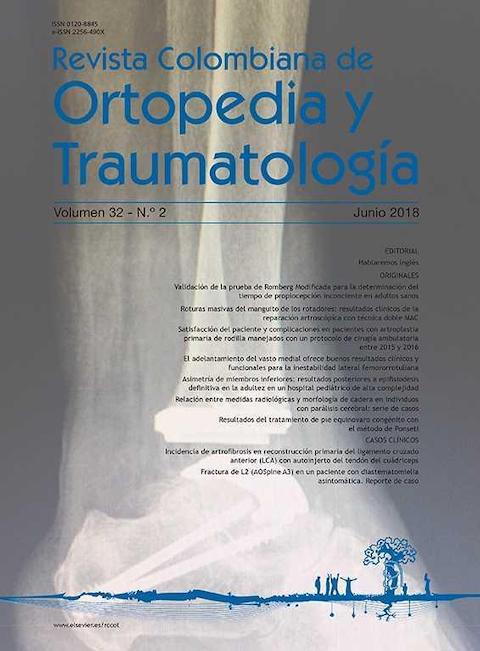Validation of a Modified Romberg’s Test to determine normal adult lower limb unconscious proprioception times
DOI:
https://doi.org/10.1016/j.rccot.2017.11.001Keywords:
proprioception, semiology, Romberg’s test, lower limbsAbstract
Background: Proprioception is considered the ability of the body to detect movement and joint position, and has great implications in neuromuscular control. There are currently no standardised clinical tests to objectively determine how much should be considered normal in its evaluation in the healthy population with a mature gait pattern. In 2012, a clinical sign called the modified Romberg test was designed to determine the proprioceptive values in the lower limbs of the normal population.
Materials and methods: A cross-sectional blind study was conducted on a cohort of patients with no history of osteoarticular injury in the lower limbs and no peripheral neuropathy. The subjects underwent the modified Romberg test, with a record made of its value in seconds in the lower right and left limbs, and comparing them with age, laterality, and gender.
Results: The study included 163 patients. On stratifying the subjects evaluated according to age groups, a tendency to decrease the modified Romberg test result with increased age was observed. According to the analysis, it can be observed that the proprioception of a limb does not have a significant difference (P=.53) with respect to the contralateral limb (laterality) or gender, but there is with respect to age.
Discussion: The modified Romberg test result of 20 seconds is a useful tool for the determination of normal proprioception in adults. This value decreases with age, without showing differences as regards the laterality or gender of the subject.
Evidence Level: IV.
Downloads
References
Lephart SM, Pincivero DM, Giraldo JL, Fu FH. The role of proprioception in the management and rehabilitation of athletic injuries. Am J Sports Med. 1997;25:130-7. https://doi.org/10.1177/036354659702500126
Cullen KE. Physiology of central pathways. Handb Clin Neurol. 2016;137:17-40. https://doi.org/10.1016/B978-0-444-63437-5.00002-9
Holm I, Fosdahl MA, Friis A, Risberg MA, Myklebust G, Steen H. Effect of neuromuscular training on proprioception, balance, muscle strength, and lower limb function in female team handball players. Clin J Sport Med. 2004;14:88-94. https://doi.org/10.1097/00042752-200403000-00006
Hillier S, Immink M, Thewlis D. Assessing proprioception: Systematic review of possibilities. Neurorehabil Neural Repair. 2015;29:933-49. https://doi.org/10.1177/1545968315573055
Wodowski AJ, Swigler CW, Liu H, Nord KM, Toy PC, Mihalko WM. Proprioception and knee arthroplasty: A literature review. Orthop Clin North Am. 2016;47:301-9. https://doi.org/10.1016/j.ocl.2015.09.005
Williams AM, Weigelt C, Harris M, Scott MA. Age-related differences in vision and proprioception in a lower limb interceptive task: The Effects of skill level and practice. Res Q Exerc Sport. 2002;73:386-95. https://doi.org/10.1080/02701367.2002.10609038
Lanska DJ, Goetz CG. Romberg's sign: development, adoption, and adaptation in the 19th century. Neurology. 2000;55: 1201-6. https://doi.org/10.1212/WNL.55.8.1201
Gadkaree SK, Sun DQ, Li C, Lin FR, Ferrucci L, Simonsick EM, Agrawal Y. Does sensory function decline independently or concomitantly with age? Data from the Baltimore Longitudinal Study of Aging. J Aging Res. 2016;2016:1-17. https://doi.org/10.1155/2016/1865038
Schmidt L, Depper L, Kerkhoff G. Effects of age, sex and arm on the precision of arm position sense-left-arm superiority in healthy right-handers. Front Hum Neurosci. 2013; 7:1-11. https://doi.org/10.3389/fnhum.2013.00915
Son SM, Kwon YH, Lee NK, Nam SH, Kim K. Deficits of movement accuracy and proprioceptive sense in the ipsi-lesional upper limb of patients with hemiparetic stroke. J Phys Ther Sci. 2013;25:567-9. https://doi.org/10.1589/jpts.25.5_567
Ribeiro Artigas N, Eltz GD, do Pinho AS, Torman VB, Hilbig A, Rieder CR. Evaluation of knee proprioception and factors related to Parkinson's disease. Neurosci J. 2016;2016: 6746010. https://doi.org/10.1155/2016/6746010
Herrera JM. Artroplastia de tobillo estado del arte. Parte I. Rev Col Or Tra. 2008;22:247-60. 13. Peláez L, Reina E, Rangel C, Reyes OE, Herrera JM. Impacto de la rehabilitación precoz tras osteosíntesis con placa antideslizante en pacientes con fracturas de tobillo de tipo B de Weber. Rev Col Or Tra. 2015;29:123-30. https://doi.org/10.1016/j.rccot.2016.03.005





